Gimme Shelter, 1970, directed by David Maysles, Albert Maysles, and Charlotte Zwerin. Some films enter the canon the minute their last frame clears the projector at a critics' screening. Other films need time and context before their greatness becomes apparent. Gimme Shelter, David Maysles, Albert Maysles, and Charlotte Zwerin's magnificent film about the Rolling Stones' 1969 tour of the States, is a sterling example of the latter group. But not for the usual reasons. In most scenarios where a film slowly becomes a classic, public taste has to catch up with the filmmakers—The King Of Comedy, for example, benefits greatly from more mainstream comedies of humiliation like "The Office." Gimme Shelter is something different, and as far as I know, unique: it needed time so that people could forget all about it. The Maysles originally planned something more like a traditional concert film, and the footage they shot at the Stones' Madison Square Garden concerts in November of 1969 pretty clearly fits that description. But the camera crews followed the band west on tour, which meant they were shooting at the Altamont Free Concert. And that's where the film's uncredited star made his appearance: The man in the green suit is Meredith Hunter, eighteen years old. Not long after this picture was taken, he pulled a gun and was promptly stabbed to death by Alan Passaro, one of the Hell's Angels keeping people off the stage. The cameras captured the whole thing, from the stabbing to Hunter's girlfriend Patty Bredahoff weeping as his body is loaded into a helicopter. And the catastrophe at Altamont was enough of a scandal that everyone involved in its planning shared some of the blame in the national media, including the film crews. It was pretty apparent that the Maysles couldn't just ignore Meredith Hunter's death and make a film like Woodstock or Monterey Pop. So they sort of made the best of it; with Charlotte Zwerin's help, they turned it into a film about Altamont, shooting the aftermath and reshaping the footage leading up to the concert so that Hunter's death becomes the inevitable climax to a slow-motion trainwreck that begins in Madison Square Garden. Regardless of whether or not they blamed the filmmakers for the concert's poor planning, critics found this in poor taste: Vincent Canby's review (original headline: "Making Murder Pay") charged the filmmakers of "epic opportunism," and Pauline Kael all but accused them of staging Hunter's death for the good of the movie. It must be said that their reactions were understandable: any film that is restructured at the eleventh hour to feature a real live death at its climax is going to carry a whiff of snuff about it. If someone gets killed at Lilith Fair this summer and Sarah McLachlan releases a film about it, I might go so far as to accuse her of exploiting a tragedy. But in the forty-odd years since Hunter's stabbing, Gimme Shelter stopped being "that failed concert film with a murder" and became "that film about Altamont." The question of who profits from Gimme Shelter seems much less interesting than the film itself. It's also undeniable that historical context has been kind to Gimme Shelter: something that couldn't have been knowable at the time. Forget, for now, about the "death of the sixties" if that kind of thing makes you feel like you've been cornered at a party by someone your parent's age who isn't aging gracefully. Let's just talk about the Rolling Stones. In 1968, they released "Beggar's Banquet." "Let It Bleed" hit store shelves on December 5, 1969, the day before Altamont. On deck: "Sticky Fingers" in 1971 and "Exile on Main St." in 1972. So within the five years around the film's release, four of the greatest records of all time. After that, the long, slow descent into self-parody: but no one could have known, in 1970, that Gimme Shelter captured the band at the absolute apex of their power as musicians and entertainers. The 1969 tour was the debut of the band's best lineup, thanks to the contributions of this man: Taylor left the band in 1974; it's not a coincidence that they did their best work while he was playing guitar for them. You know the rest of the group, although I'd wager you haven't seen them looking this young in a while: And of course, Mr. "Richard" and Sir Michael Jagger. It's not just that this is the middle of the band's greatest period: it's that the Stones are still around, and have spent the last 30 years or so systematically sucking every last dime from their past glories. Watching Gimme Shelter, you almost wish someone at the mastering sessions for Exile on Main St. had slipped them a hot shot and a copy of Housman. But in 1970, no one could have predicted Zombie Keith Richards or Charming Old Pensioner Watts, and no audience or critic could have known how affecting it would be to see the band at their prime again. And all right, let's get into the death of the sixties stuff. To me, if there was a signature event that brought on all the horrors of the 1970s, it was in 1972 with Nixon's victory over McGovern. But a lot of people would disagree with me on that: specifically the people who wrote the booklet essays for Criterion. For them, Altamont was the moment they were finally clobbered over the head with the fact that peace, love, and understanding wasn't going to be enough to save the world: this was a historical moment that resonated for years to come. Whether or not you agree with them, Gimme Shelter meticulously documents a lot of really naïve people running headfirst into atavistic tribalism and violence.1 And no matter where exactly in your timeline you jab the pushpin, that's how the sixties died. That's the context, but what about the movie? The fact is, whether or not it was in poor taste, Zwerin and the Maysles brothers did an amazing job of building a film around the Altamont catastrophe. Those stills of the band are all after Altamont, after the filmmakers knew they had footage of Hunter's stabbing, from a session where they invited the filmmakers to view rough sequences from the film, and caught them on camera reacting to themselves. And that's from the beginning of the movie: the first time we see the film's title, it's on an editing rig. Just as in the editing sequence in Man With A Movie Camera (and oddly for what's ostensibly cinéma vérité), we're forcibly made aware that we're watching a manipulated reality, in which events happen out of sequence, circling Hunter's death like blood down a drain. This is brilliant (and essential) structurally, but it's also crucial for tone and theme. One of the film's great questions is the extent to which the Stones' manufactured stage personae contributed to the disaster at Altamont. By having the Stones watch themselves, the filmmakers create one of the most succinct critiques of celebrity on film. We see Mick Jagger clowning around at a press conference at the beginning of the tour: When asked by a female reporter if he and the band are "more satisfied" now than they were in the past, he asks if she means sexually, financially, or philosophically and then replies that they are "Financially dissatisfied, sexually satisfied, philosophically trying." It's a bullshit answer to a bullshit question, and the reporters eat it up. Months later, Jagger watches his response, hangs his head, and pronounces it "Rubbish." It's not clear whether he's critiquing his answer or his performance, although in either case he's right. It seems clear that he's drawing a line between Michael Jagger and "Mick Jagger," until you remember that he's just taken a drubbing in the press over Altamont and knows he's on camera. It's a question that comes back again and again: cinéma vérité promises authenticity, but do these guys ever stop performing? Jagger, at least, seems to be able to turn it on and off like a faucet. We see the band walk into a Holiday Inn: Keith looks a little crazy, but Mick looks like the London School of Economics student he once was: In the very next shot, the band is leaving the hotel. The rest of the band looks the same, but now they're accompanied by Mick Fucking Jagger, Rock Star. So this is an act. But it isn't all an act, because these guys really were the greatest rock and roll band in the world, and Gimme Shelter makes sure you know it. Before the first mention of Meredith Hunter, the film gives us an absolute barnburner performance of "Jumpin' Jack Flash," and let me just say that if you have never seen Mick Jagger command a stage in his prime, you don't know anything about the Rolling Stones.2 He's too kinetic to be captured in a still; you're gonna have to watch the movie. Of course, Mick's command of the stage was part of the problem. His entire stage presence was built around taunts and provocation (sample patter: "You wouldn't want my trousers to fall down, now, would you?") and the Stones' music is not what you would call peaceful. So they were exceptionally great at riling people up; not so great at calming them down. By the time we see them perform "Honkey Tonk Blues," later in the film, we know Altamont is on the way. Which makes it ominous to see Jagger deal with fans who rush the stage; he just gets out of their way, lets the bouncers carry them off, and keeps singing. Ignoring the chaos around him is not going to be a great long-term strategy. At about the same time, the filmmakers give the audience a different model of stage presence: Ike and Tina Turner performing Otis Redding's "I've Been Loving You Too Long." The Stones' show is built around promising release, then denying it; Ike and Tina end the song with what appears to be an onstage orgasm and a whole lot of inappropriate microphone fondling. It's just as provocative, but it's not built around chaos, and the audience is mesmerised, not rioting. Jagger's sullen response, watching footage of the opening act blowing him out of the water? "It's nice to have a chick occasionally. Not in complete control of his emotions there. Adding to the sense of unease by this point is footage of Melvin Belli frantically negotiating with Dick Carter for the use of the Altamont Speedway. The original location for the concert had fallen apart, as had the backup location, and the Stones organization brought in the King of Torts, who you might recall from Brian Cox's portrayal of him in Zodiac. Belli was by all accounts a brilliant lawyer, but his office is decorated like an Applebee's managed by Miss Havisham, and doesn't exactly give the impression of a man for whom organization came easily. He's pretty cavalier about the whole thing: they have hundreds of thousands of would-be-concertgoers descending on San Francisco for a concert, no toilets, no parking, no doctors, nothing, but everyone seems to think everything will just sort of work out somehow. Someone in the room says it's like "lemmings to the sea," and they're not far off. By the time the concert starts, disaster seems inevitable. This: Is not a man who is culturally prepared to deal with this: That's one of the Hell's Angels. Depending who you ask, they were either hired or decided on their own to provide "security" with weighted pool cues. They weren't exactly what you'd call Stones fans, judging by the look one of them gives Mick Jagger: Over the course of the afternoon, they got drunk and out of control: they punched out Marty Balin during the Jefferson Airplane's set, they beat the crap out of any number of concertgoers, and when Meredith Hunter pulled a gun, they stabbed him to death. Despite their rough edges, the Stones were about as well prepared for real violence as that guy with the magic wand. Arriving at the concert, Mick gets immediately punched in the face; when fights break out, all Jagger can muster up is, "If we are all one, let's show we're all one." That sentiment is exactly as effective as you'd imagine. Sonny Barger and company weren't interested in being "one" with a bunch of hippies. Especially not hippies who were—as Sonny pointed out in a radio interview after the concert—messing with their bikes: they "got got." And unfortunately for the Stones, being able to work a crowd into a frenzy does not mean you can get that same crowd to chill the fuck out. It's a different skill set. So that was Altamont: a slow-moving catastrophe where none of the people who could have stopped things were paying enough attention. But the cameras were rolling. Albert Maysles, David Maysles, and Charlotte Zwerin couldn't see what they had until they got into the editing room and shaped it into something coherent. Most critics couldn't see what they'd created until decades later, when the film's origin had faded and the Rolling Stones had gone on to Super Bowls and president's birthday parties. What are we left with? Gimme Shelter is an undeniably great concert film, and if not for Altamont, that's exactly what it would have been. It's also a process documentary about a very badly planned concert, but it's more than that, too. I hesitate to pronounce it the obituary for sixties, although at times it certainly wants to be. For me, the film's most interesting moments have to do with Jagger's control of his public persona: the moments when you see his façade slip and immediately get put back in place. Watch Gimme Shelter carefully, and you will see the Rolling Stones become the greatest rock and roll band in the world through sheer force of will. Even if people have to die. Randoms 1Which is pretty much what happened to the McGovern campaign, come to think of it. 2I didn't: Gimme Shelter was how I got into the Stones, after Oldies Radio and the Steel Wheels tour poisoned them for me.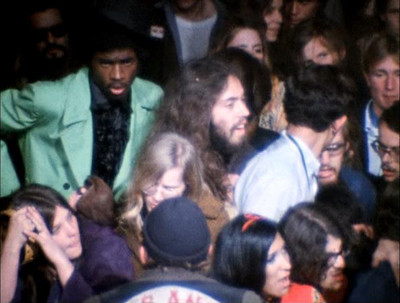
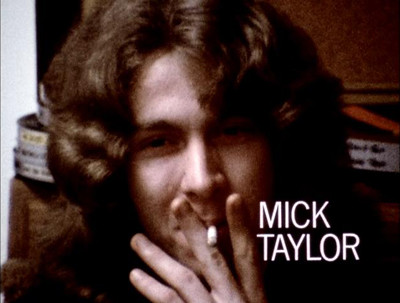
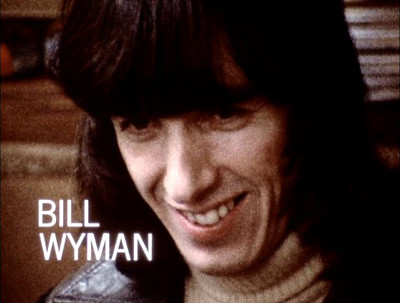

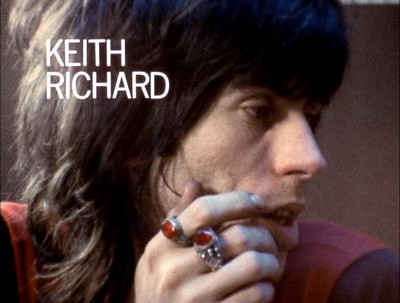
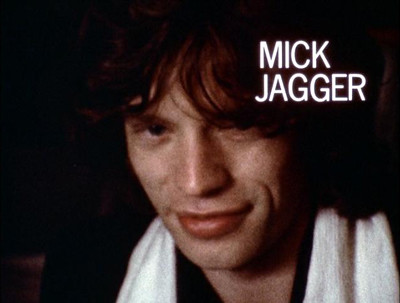


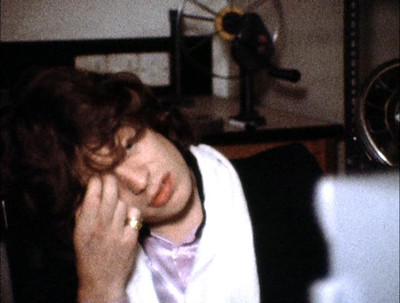

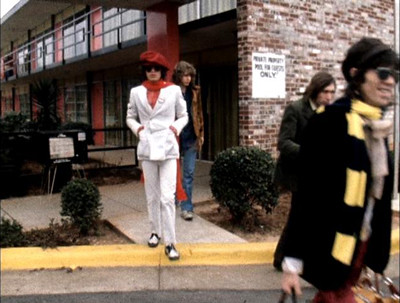
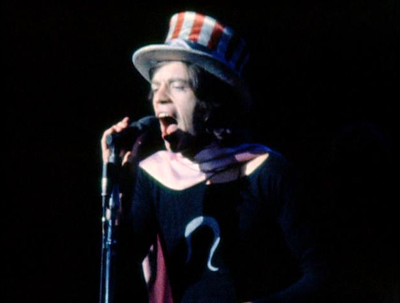
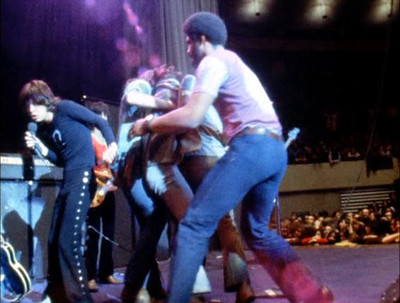

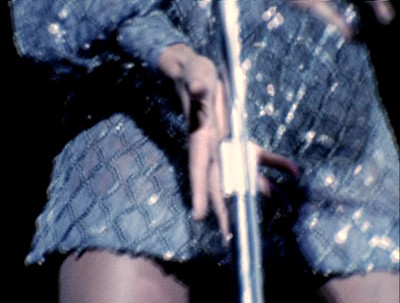




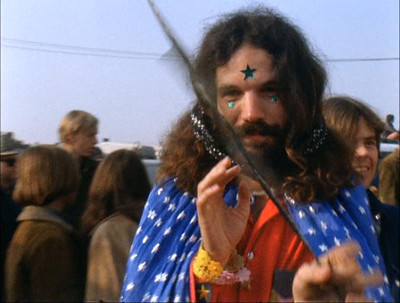


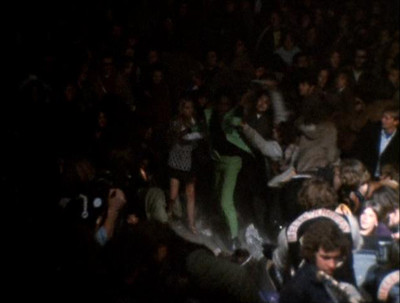
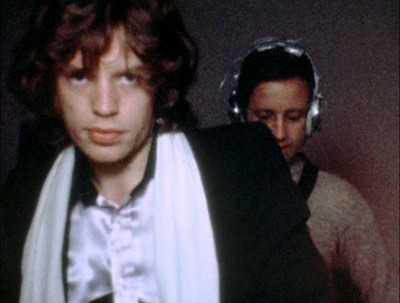
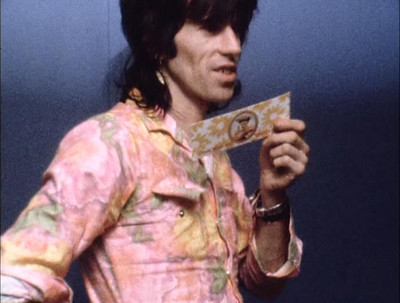
Cousin Minnie says, "How dee-licious!"
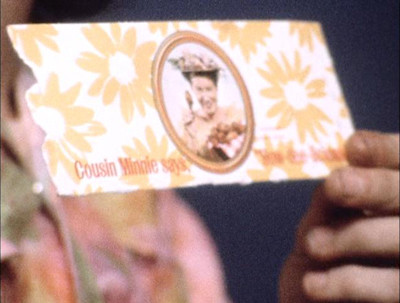
Minnie Pearl's Fried Chicken is no longer with us: it flamed out in a political scandal as big as Altamont. If you ask me, that's when the sixties really died.

It looks like something Robert Capa might have shot.
Spielberg Scorsese (thanks, anonymous commenter—don't know what I was thinking) was one of the cameramen at Woodstock).
Friday, July 16, 2010
#99: Gimme Shelter
Subscribe to:
Post Comments (Atom)


32 comments:
Great write up. Love the Mick Taylor acknoledgement. There are boatloads of fans who agree with you on this count. It is worth mentioning that Keith was at the absolute top of his game at this point, and the interplay between the two (with Keith's hacking style and Mick Taylor's fluid style) is what made the magic happen.
One thing that's fun about this film is to compare the Madison Square Garden performances in it (which weren't overdubbed) with live album recorded from those same performances (Get Yer Ya Yas Out) which has some significant overdubs.
I don't see you you can shift any of the blame about Altamont to the film makers - they were just there to document the day. They weren't the planners, just hired hands. They literally had a contract that allowed them to film the New York shows plus Altamont. Even getting a release from the band to allow them to release the film was a major hurdle later on.
You missed one of the great footnotes of all time: one of the camera operators at Altamont was a young George Lucas. Whether any of his film was usuable is another story.
A little historical reference gives the Mel Belli scenes a new angle. According to Sam Cutler's book (Sam was the road manager for the tour and the guy who said the line "The greatest rock and roll band in the world"), Mel Belli and some of the others at his office (one of whom later defrauded Rosalyn Carter and served time) were nothing but giant posers pretending to be in charge of organizing the festival. The band's actual representatives had to fight tooth and nail against them every step. The problem was that once Jagger announced the date and location of the free concert at the New York press conference, there was no way to stop it. So they were committed one way or the other.
One of the security guys you see in the Honkey Tonk Women clip from MSG broke his hand at Altamont. You can see a splint on it by the end of the show. He's still around and has aged a little better than just about everybody else in the movie. He later did some security work for Jim Morrison.
Now, to the most important aspect of the movie: the violence and murder. An examination of the perps swinging pool cues shows that most of them were not actual members of the Hell's Angels, but provisional members. It appears that they were trying to impress the real guys with their bravado.
As for the late Meredith Hunter, one of the persistent questions is why he pulled out his gun. The only answer I've ever heard (which I read in a book of dubious reputation) is that the Angels were severely harrassing him because of his white girlfriend, and he had to pull it in self defense.
Good post, as usual, except that McGovern lost to Nixon in 1972. Nixon (narrowly) beat Humphrey in '68.
Nagaijin,
You're right--I'm a moron! I've corrected it.
Great review that makes me want to revisit this film to give it another chance. Gimme Shelter had long been on my list of films to see (ever since it was a staple of the 70s revival circuit), and I finally caught it as part of my own Criterion completist quest. Despite subject matter that should have been engrossing, the movie never really sucked me in like the best documentaries do (in general movies either do or don't bring a viewer fully in, no critical analysis by that viewer can change that). Also, the musical performances that the Maysle's caught didn't generally show the performers at the top of their game, and weren't visually exciting.
You should be looking forward to hitting Monterey Pop, which besides being a great concert film is one of the all-time best packages of material that Criterion has put together.
YOu're almost at 100! In my own criterion quest (which has covered spines 21-231 so far) spine 100, the Beastie Boys Anthology, is the only one I couldn't bring myself to complete. I'm curious to see how you do.
Did you catch the new doc Stones in Exile? Been meaning to, and I'm wondering how you liked it.
If I remember correctly, Hunter S. Thompson has a lot to say in "Hell's Angels" about the relationship between the hippies and the bikers, and how it all went so predictably wrong.
Great entry as always. Love this blog!
I like your discussion of when the 70's began. I go with May 4, 1970. I maintain that the sixties really began on November 8, 1960 with the election of JFK and ended with the gunshots at Kent State, but both your argument at the Criterion booklet argument are valid as well.
I'm a fan of the Maysles via Grey Gardens and the Christo documentaries, but haven't seen this one yet. It's been on my list for a long-ass time. I'm a Stones fan for the peak period you describe, and yeah, I admit I saw the Steel Wheels tour too. I was just out of high school then. Proud to say Guns n Roses blew the Stones away. All I remember of the Stones set was that every song was over extended and jammed to death. I love your entry for this doc. It makes me want to see it. But please tell me you don't eat at Applebees. -- Shawn McGuire
You are wrong about Mick Taylor. The Rolling Stones started going downhill when Brian Jones died. Great article otherwise, as always.
It always seemed strange to me that nobody wrote a definitive book on Altamont. There's very little information out there about Meredith Hunter, for instance; what was his deal? Why did he bring a gun to the show? Did anybody ever interview his girlfriend? I'd like answers to some of the other questions the movie raises, too... like what's up with the very drugged out naked fat woman that wandered on the stage like a zombie? I'd love to see an interview with her today.
The whole thing has an aura of mystery, as if this is a document from hundreds of years ago.
The True Adventures of the Rolling Stones (aka Dance with the Devil) by Stanley Booth is a pretty good account of both band and event.
Nice write-up of this great documentary.
R-man,
That's a fantastically well-informed comment. I meant to add the George Lucas thing, but it was late and I was ready to sleep (as my error re: McGovern shows). I've added it and credited you.
Mark,
It's worth revisiting. I think the performances are better than you do, it sounds like. Haven't seen "Stones in Exile," and, yeah, I'm currently slogging my way through the Beastie Boys Anthology. Night of a thousand remixes...
JPL,
I'll look for it. Hunter S. Thompson is always fun to read, whether he's wildly off-base or not.
Joint Group Howls,
Thanks!
Erik,
Kent State works for me. As it happens I was just reading Perlstein on the response of the local townspeople. Same story all over again: ignore tribalism at your mortal peril.
Shawn,
I try to avoid any restaurant that decorates by gluing shit to the walls. Unfortunately, I didn't see the Steel Wheels tour, I just remember it happening and thinking, "really?"
Kim,
That would mean "Let It Bleed" was a worse album than, say, "England's Newest Hitmakers," which I refuse to accept. Re: Meredith Hunter, you're not the only person who thinks there's an interesting story there (haven't seen it -- if you do, let me know how it is). But my favorite mysterious long-forgotten black man is Lloyd Gaines.
JPK,
Thanks for the recommendation; I'll check it out.
Spielberg at Woodstock? No no no, Martin Scorsese was part of the Woodstock film crew. Spielberg was making "Amblin" and directing episodes of "Night Gallery" and "Ben Casey".
Anonymous,
This may be my least-accurate blog post ever. At least I got the name of the band right. ("Bears? The Rolling Bears?")
Matthew,
Don't be hard on yourself - you did a great job - certainly better than I did on the spelling in my earlier comment. This is just a hard movie to review - there's a lot happening in it. And any review that starts out with a nod to Mick Taylor is on the right track.
And hey, I never knew the back story behind Minnie Pearl's Fried Chicken until I read your review.
Not that this is that important, but I finally found a quote from Albert Maysles about George Lucas's camera work at Altamont.
From the Wall Street Journal article "The Stones at the Speedway . . ." by Marc Myers:
After their set, the Stones and their entourage are shown flying out by helicopter. Meanwhile, concertgoers are captured in silhouette, stumbling in the dark trying to leave the concert grounds. "George Lucas was one of our young cameramen and shot that," Mr. Maysles said. "It's like a sci-fi scene."
I hate to be "that guy" who only comments on typos, but I imagine Mr. Balin would prefer to be called Marty and not Mary.
All that aside, this was one of your best essays. I always try to read what you have written after I watch a Criterion, but in the case of this one, you've convinced me that I need to go out and buy "Gimme Shelter".
Good write up, but that isn't Sonny Barger.
Remember the scene right before the Stones going to the stage, when the Angels are taking their bikes through the crowd?
The guy with the beard and the girl at the head of the column is Sonny Barger.
Oh, and Marty got punched, not "Mary."
Does anyone know who took the bottom photo. Even better, does anyone know where a hi res version could be obtained?
Thanks you for your time!
I wonder why the conversation between Mel Belli and the guy on the phone (early in the film) concerning the concert being moved is not the same conversation in the original film. It's a completely different person on the other end of the phone (but the gist of the conversation is the same).
Thanks for the typo corrections, anonymous folks--fixed. Anonymous the last--when you say "in the original film," what do you mean? Is there a different version than what's on the DVD?
Matthew, I guess by "original version" I mean the one that I have seen over and over in theatres and VHS. Pre-Criterion, if you will. In the phone conversation I'm referencing Belli is talking with someone about the concert venue being changed, and the guy on the other end says "this whole thing is one big pain in the ass." Then goes on to ask Belli if he's in touch with Jagger...of course, Belli's responses jibe with the conversation he has in the most curent DVD release. But it's a different conversation. I know it doesn't make much sense, but it's got me wondering.
More info
Excellent exploration of this classic. Interesting that the telephone conversation Mel Belli is different on this DVD than earlier. I have a VHS cassette recorded from VH1 probably during the promos for the Voodoo Lounge tour, but have no way to view that at present. Very curious to see that again, now. Some of the faces in the crowd seem to be such interesting people, sure would like to see some of these 300,000 people interviewed!
...Great article, except Taylor was in the band from 1969-74. The Stones put out their best work from '65-'72. Just sayin.' ;)...and IMO, the best line-up is the one where Mick n' Keef are writing their best material; that would be the one I just listed above...Kudos!
Selvin's new book Altamont answers a lot of questions in this post. He covers Hunter, the Angels, why the Stones wanted a free concert in the first place and how it can all go wrong when the audience, the bands and the Angels are all tripping on acid, booze and other drugs.
Selvin (and it's hard not to agree with him) puts most of the blame on the Stones for the mess though he also makes sure the other parties come in for their share.
Post a Comment